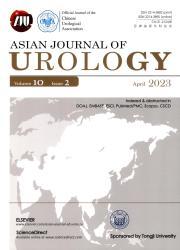Erectile function after laparoscopic versus robotic-assisted radical prostatectomy: A systematic review and meta-analysis
IF 2.4
3区 医学
Q2 UROLOGY & NEPHROLOGY
引用次数: 0
Abstract
Objective
Prostate cancer is a common malignancy in men over 50 years old, and radical prostatectomy, particularly via laparoscopic and robotic-assisted techniques, significantly impacts quality of life, especially in terms of erectile dysfunction. This systematic review and meta-analysis aimed to evaluate the preservation of erectile function following robotic-assisted and laparoscopic radical prostatectomy, with a separate analysis of randomized clinical trials and non-randomized studies.
Methods
This review was carried out using randomized and non-randomized studies involving adult patients diagnosed with localized prostate cancer undergoing radical prostatectomy, according to Preferred Reporting Items for Systematic reviews and Meta-Analyses guidelines and registered in PROSPERO. Applicable literature from PubMed, Cochrane, Embase, and the Latin American and Caribbean Health Sciences Literature database was analysed. The bias in randomized clinical trials was assessed using the Cochrane Risk of Bias 2.0 tool, and observational studies were evaluated via the Newcastle-Ottawa Scale. The statistical analysis was performed using Review Manager version 5.4.
Results
Our analysis included 13 studies involving 6281 patients. Comparative meta-analysis of non-randomized studies demonstrated that robotic techniques were significantly more effective in preserving erectile function at 3 months (risk difference [RD] 0.05, 95% confidence interval [CI] 0.00–0.11; p=0.040), 6 months (RD 0.10, 95% CI 0.03–0.17; p=0.006), and 12 months postoperatively (RD 0.06, 95% CI 0.02–0.10; p=0.002).
Conclusion
Robotic-assisted surgery showed greater preservation of erectile function 3 months, 6 months, and 12 months after radical prostatectomy. However, additional studies with meticulous methodological criteria are necessary for future analysis.
腹腔镜与机器人辅助根治性前列腺切除术后的勃起功能:一项系统综述和荟萃分析
前列腺癌是50岁以上男性常见的恶性肿瘤,根治性前列腺切除术,特别是通过腹腔镜和机器人辅助技术,显著影响生活质量,特别是在勃起功能障碍方面。本系统综述和荟萃分析旨在评估机器人辅助和腹腔镜根治性前列腺切除术后勃起功能的保存,并对随机临床试验和非随机研究进行单独分析。方法:本综述采用随机和非随机研究,纳入诊断为局限性前列腺癌接受根治性前列腺切除术的成年患者,根据系统评价和荟萃分析指南的首选报告项目,并在PROSPERO注册。分析了PubMed、Cochrane、Embase以及拉丁美洲和加勒比健康科学文献数据库的适用文献。随机临床试验的偏倚采用Cochrane风险偏倚2.0工具进行评估,观察性研究采用纽卡斯尔-渥太华量表进行评估。使用Review Manager版本5.4进行统计分析。结果纳入13项研究,涉及6281例患者。非随机研究的比较荟萃分析表明,机器人技术在术后3个月(风险差异[RD] 0.05, 95%可信区间[CI] 0.00-0.11; p=0.040)、6个月(RD 0.10, 95% CI 0.03-0.17; p=0.006)和12个月(RD 0.06, 95% CI 0.02-0.10; p=0.002)时更有效地保持勃起功能。结论在根治性前列腺切除术后3个月、6个月和12个月,机器人辅助手术能更好地保护勃起功能。然而,未来的分析还需要进一步的研究和细致的方法学标准。
本文章由计算机程序翻译,如有差异,请以英文原文为准。
求助全文
约1分钟内获得全文
求助全文
来源期刊

Asian Journal of Urology
UROLOGY & NEPHROLOGY-
CiteScore
4.00
自引率
3.80%
发文量
100
审稿时长
4 weeks
期刊介绍:
Asian Journal of Urology (AJUR), launched in October 2014, is an international peer-reviewed Open Access journal jointly founded by Shanghai Association for Science and Technology (SAST) and Second Military Medical University (SMMU). AJUR aims to build a communication platform for international researchers to effectively share scholarly achievements. It focuses on all specialties of urology both scientifically and clinically, with article types widely covering editorials, opinions, perspectives, reviews and mini-reviews, original articles, cases reports, rapid communications, and letters, etc. Fields of particular interest to the journal including, but not limited to: • Surgical oncology • Endourology • Calculi • Female urology • Erectile dysfunction • Infertility • Pediatric urology • Renal transplantation • Reconstructive surgery • Radiology • Pathology • Neurourology.
 求助内容:
求助内容: 应助结果提醒方式:
应助结果提醒方式:


